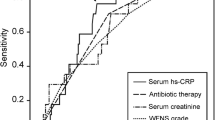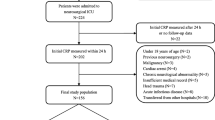Abstract
Background
The purpose of this study was to assess whether preanesthetic laboratory values can predict in-hospital mortality and morbidity in patients who have undergone burr hole craniostomy due to chronic subdural hematoma.
Methods
From January 2007 to February 2016, the records of 502 consecutive patients who underwent burr hole craniotomy were analyzed. All cases of burr hole craniostomy were fitted with a drain, as required by our institutional protocol.
Results
Patients’ demographic data and preoperative laboratory values were subjected to logistic regression analysis to predict in-hospital mortality and morbidity after burr hole craniostomy. Hemoglobin, prothrombin time, activated partial thromboplastin time, serum glucose, and high-sensitivity C-reactive protein (hsCRP) were found to be significantly associated with in-hospital mortality and morbidity by univariate regression analysis, but of these, only hsCRP (hazard ratio 1.210, 95 % confidence interval 1.089–1.345, P < 0.001) was found to significantly predict in-hospital mortality and morbidity by multivariate regression analysis. Areas under the curve for predicting in-hospital mortality and morbidity were 0.765 (95 % confidence interval 0.624–0.906, P = 0.002) and 0.646 (0.559–0.733, P = 0.001), respectively.
Conclusions
Preoperative hsCRP was found to be an independent predictor of in-hospital mortality and morbidity after burr hole craniostomy due to chronic subdural hematoma.

Similar content being viewed by others
References
Gelabert-González M, Iglesias-Pais M, García-Allut A, Martínez-Rumbo R. Chronic subdural haematoma: surgical treatment and outcome in 1000 cases. Clin Neurol Neurosurg. 2005;107:223–9.
Miranda LB, Braxton E, Hobbs J, Quigley MR. Chronic subdural hematoma in the elderly: not a benign disease. J Neurosurg. 2011;114:72–6.
Van Beek JG, Mushkudiani NA, Steyerberg EW, Butcher I, McHugh GS, Lu J, Marmarou A, Murray GD, Maas AI. Prognostic value of admission laboratory parameters in traumatic brain injury: results from the IMPACT study. J Neurotrauma. 2007;24:315–28.
Gabay C, Kushner I. Acute-phase proteins and other systemic responses to inflammation. N Engl J Med. 1999;340:448–54.
Sogut O, Guloglu C, Orak M, Sayhan MB, Gokdemir MT, Ustundag M, Akkus Z. Trauma scores and neuron-specific enolase, cytokine and C-reactive protein levels as predictors of mortality in patients with blunt head trauma. J Int Med Res. 2010;38:1708–20.
Su SH, Xu W, Li M, Zhang L, Wu YF, Yu F, Hai J. Elevated C-reactive protein levels may be a predictor of persistent unfavourable symptoms in patients with mild traumatic brain injury: a preliminary study. Brain Behav Immun. 2014;38:111–7.
Hergenroeder G, Redell JB, Moore AN, Dubinsky WP, Funk RT, Crommett J, Clifton GL, Levine R, Valadka A, Dash PK. Identification of serum biomarkers in brain-injured adults: potential for predicting elevated intracranial pressure. J Neurotrauma. 2008;25:79–93.
Taussky P, Fandino J, Landolt H. Number of burr holes as independent predictor of postoperative recurrence in chronic subdural haematoma. Br J Neurosurg. 2008;22:279–82.
Alcalá-Cerra G, Young AM, Moscote-Salazar LR, Paternina-Caicedo A. Efficacy and safety of subdural drains after burr-hole evacuation of chronic subdural hematomas: systematic review and meta-analysis of randomized controlled trials. World Neurosurg. 2014;82:1148–57.
Chon KH, Lee JM, Koh EJ, Choi HY. Independent predictors for recurrence of chronic subdural hematoma. Acta Neurochir (Wien). 2012;154:1541–8.
Ramachandran R, Hegde T. Chronic subdural hematomas—causes of morbidity and mortality. Surg Neurol. 2007;67:367–72 (discussion 372–3).
Frati A, Salvati M, Mainiero F, Ippoliti F, Rocchi G, Raco A, Caroli E, Cantore G, Delfini R. Inflammation markers and risk factors for recurrence in 35 patients with a posttraumatic chronic subdural hematoma: a prospective study. J Neurosurg. 2004;100:24–32.
Pober JS, Cotran RS. Cytokines and endothelial cell biology. Physiol Rev. 1990;70:427–51.
Huang Y, Jing J, Zhao XQ, Wang CX, Wang YL, Liu GF, Wang CJ, Liu LP, Yang XM, Jiao Y, Jiao Y, Wang LS, Wang YJ, Gu WK. High-sensitivity C-reactive protein is a strong risk factor for death after acute ischemic stroke among Chinese. CNS Neurosci Ther. 2012;18:261–6.
Gach O, Legrand V, Biessaux Y, Chapelle JP, Vanbelle S, Pierard LA. Long-term prognostic significance of high-sensitivity C-reactive protein before and after coronary angioplasty in patients with stable angina pectoris. Am J Cardiol. 2007;99:31–5.
Nouvenne A, Ticinesi A, Lauretani F, Maggio M, Lippi G, Prati B, Borghi L, Meschi T. The prognostic value of high-sensitivity C-reactive protein and prealbumin for short-term mortality in acutely hospitalized multimorbid elderly patients: a prospective cohort study. J Nutr Health Aging. 2016;20:462–8.
Bazeley J, Bieber B, Li Y, Morgenstern H, de Sequera P, Combe C, Yamamoto H, Gallagher M, Port FK, Robinson BM. C-reactive protein and prediction of 1-year mortality in prevalent hemodialysis patients. Clin J Am Soc Nephrol. 2011;6:2452–61.
De Bonis P, Trevisi G, de Waure C, Sferrazza A, Volpe M, Pompucci A, Anile C, Mangiola A. Antiplatelet/anticoagulant agents and chronic subdural hematoma in the elderly. PLoS One. 2013;8:e68732.
Torihashi K, Sadamasa N, Yoshida K, Narumi O, Chin M, Yamagata S. Independent predictors for recurrence of chronic subdural hematoma: a review of 343 consecutive surgical cases. Neurosurgery. 2008;63:1125–9 (discussion 1129).
Merican I, Guan R, Amarapuka D, Alexander MJ, Chutaputti A, Chien RN, Hasnian SS, Leung N, Lesmana L, Phiet PH, Sjalfoellah Noer HM, Sollano J, Sun HS, Xu DZ. Chronic hepatitis B virus infection in Asian countries. J Gastroenterol Hepatol. 2000;15:1356–61.
Is M, Coskun A, Sanus GZ, Tanriverdi T, Kafadar AM, Hanimoglu H, Tanriover N, Gezen F, Uzan M. High-sensitivity C-reactive protein levels in cerebrospinal fluid and serum in severe head injury: relationship to tumor necrosis factor-alpha and interleukin-6. J Clin Neurosci. 2007;14:1163–71.
Author information
Authors and Affiliations
Corresponding author
Ethics declarations
Conflict of interest
The authors declare no competing interests.
About this article
Cite this article
Choi, J.J., Kim, H.S., Lee, K.C. et al. Prediction of in-hospital mortality and morbidity using high-sensitivity C-reactive protein after burr hole craniostomy. J Anesth 30, 956–960 (2016). https://doi.org/10.1007/s00540-016-2259-1
Received:
Accepted:
Published:
Issue Date:
DOI: https://doi.org/10.1007/s00540-016-2259-1




